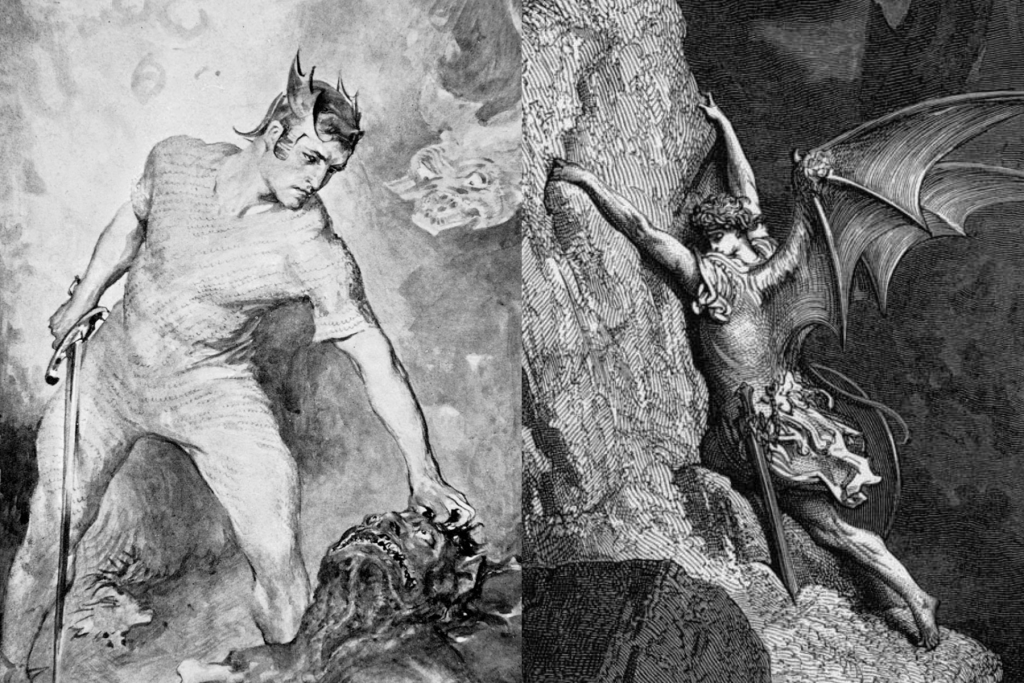
By: Norman Hilker
Arguably, the most immersion you can get out of reading a text is seeing yourself in the shoes of a character. While it is fun to see one’s characteristics displayed through the actions or phrases of a supporting character, it is much more personal when we see ourselves as the protagonist. That being said, I will be delving into the background of heroic protagonists in British literature, exclusively in the epic genre. This research’s focus will broadly range from the early British works in medieval times to works of the last few hundred years. The characters I think of when narrowing down my evidence will be Beowulf and Satan from John Milton’s Paradise Lost.
The hero archetype has been continually evolving ever since the birth of literature. Before English histories and epics, heroes were portrayed as underdogs who utilized powers, faced various trials and tribulations, and came out as a more respected individual within their community (Stafford). Due to the rise of monarchies and social progress, the archetype was further analyzed in the context of knights and warriors. Their chivalry, loyalty, and most of all courage were displayed through their acts and placement of others over themselves. While the more chivalric heroes overcame internal conflict, epic heroes endured more physical ones (Stafford), as the nature of epic stories and poems of the time period reflected the length and events at which an author would cover. Since each of these stories follow their protagonist closely, as their names are typically the titles, it can be argued that the journey an epic hero takes correlates with the very definition of epic.
It’s important to take into account that not all epics are the same if we are going to analyze the characterizations of these protagonists; this will depend on the time period, the culture within the respective society, and even the morality that attributes to the hero. In terms of the epic genre, we’re dealing with a generally longer narrative with breaks in structure and subtle significance in the hero’s actions (Rafiq). One thing to point out about epic heroes is the author’s ability to reach their status for the audience, in that this makes it easier for someone of an arguably lower stature to get a grasp at these characters’ emotions and inner thoughts. One of the lessons we can get out of epics is that in the end, we are all human and that no matter what our status is, we can in one way or another relate to what a character is going through. Not only does this dwelling on the character keep a good, central focus in a story that otherwise delves into many themes and events from beginning to end, it employs language tools such as exaggeration to keep the hero’s status elevated as well as elegant language to transport the reader to a different atmosphere (Rafiq).
Through the lens of this era of literature and storytelling, we find that heroes can be more than defined as people who go out of their way to help the common good. Their characters can give readers of the time a closer look at how they’re coming to terms with conflict in epic proportions. In this website’s further reading, I will be taking what I learned from epic heroes and their conventions and applying it to protagonists of well known British literature, specifically the title character from Beowulf and Paradise Lost’s Satan. In doing so, I will also analyze what makes each character compelling in their own ways that stem off of the traditional tropes of the epic hero.
Works Cited
Rafiq, Muhammad. “The Epic: Definition, Types & Characteristics.” Owlcation, 1 Sept. 2019, owlcation.com/humanities/The-Epic-Definition-Types-Characteristics.
Stafford, Malakai. “Comparison of Heroes in Early English Literature – 1578 Words: Essay Example.” Free Essays, 24 Oct. 2018, ivypanda.com/essays/comparison-of-heroes-in-early-english-literature/.